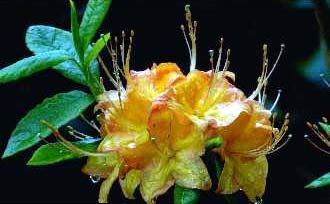The naturalistic garden draws its inspiration from nature. A walk through the woods or a meadow, or alongside a river, will provide you with a wealth of ideas for design.
What is meant by the term "naturalistic garden"? Does it imply just sitting back and letting nature take its course, allowing anything and everything to grow as it will? No doubt that would prove a bonanza for some species of animals and plants, but the gardener would have no role to play. In the naturalistic garden, the gardener is still present, with a guiding hand - but more subdued than usual.
Observing Nature about Us
Nowadays many gardens seem much alike. Neatly trimmed lawns are bordered by the same obligatory conifers and ground covers. Garden paths and patios are made of concrete and laid out in straight lines. But if you look around at the natural landscape, you will find that every scene is different. Each one reflects the interplay of very specific criteria, including climate, contour of the land, and soil. Every environment is home only to specific plant and animal species.
The goal of the naturalistic garden is to take these characteristic elements and translate them to a human scale. When that is done, the garden becomes integrated into and not estranged from its larger surroundings. Animals and plants can find a haven in it, and human beings can find relaxation and joy in the rich, harmonious variety of life abounding in the garden.
Making Use of Natural Materials
The building materials used to design the garden should be as natural as possible. For example, benches and paths could be constructed from natural stone slabs, and moss will soon form in the cracks. Paths can be attractively designed and executed of flagstone, gravel, brick, wood planks, or bark chips. The only real consideration is that water be able to run off into the subsoil.
You will need a little of your own sensitivity and creativity, however, when selecting materials to build a fence. Again, have a look around your immediate environs. What characterizes or blends in best with the existing landscape? Would picturesque natural stone, simple wooden posts, or a dense, impenetrable hedge be more appropriate? If you have no recourse other than chain-link fencing, then you can consider masking its sterility with climbing and twining plants and suitable decorative shrubs.
Shrubs
Shrubs provide the best environment for many bees, butterflies, birds, and small animals. Their foliage, flowers, and fruits are decorative. Shrubs provide privacy by screening out unwanted glances, and they serve as barriers against the wind. If there is enough room in your garden for one, you should opt for an informal hedge. Draw your inspiration from the bushes and shrubs easily found in woods and fields.
Trees
If you are fortunate enough to have some old trees growing on your property, by all means keep them. If you are planting from scratch, however, use native deciduous trees that will provide birds. These same trees also offer nesting and hiding places for birds, squirrels, and raccoons.
In selecting species to plant, keep in mind the future sizes of the mature trees and their cultivation requirements. Beeches, oaks, and maples are best suited to large gardens; mountain ashes, wild cherry trees, and other fruit trees are suited to small ones.
Rock, Sand, and Gravel
Sandy soil that is low in humus content provides a useful habitat for certain kinds of naturalistic gardens. It is ideal for creating a wildflower meadow. If the soil is alkaline, pasqueflowers, meadow-sweets, and thyme will flourish. Broom, common heather, cinquefoil, maiden pink, and catch flies will attract butterflies. A sunny meadow will attract honeybees. Dry walls and stone outcroppings will draw small lizards and chipmunks.
Perennials, Herbs, and Bulbs
Use a garden fork to loosen and aerate the soil. That way you will keep intact the natural layering and the corresponding levels of oxygen that are so crucial to microscopic soil organisms. Many medicinal herbs, select perennials, annuals, and bulbs will do well in naturalistic gardens. Avoid planting double varieties. In doubles, stamens have been transformed into petals; stamens contain pollen, and insects find no nourishment in double flowers.
TIPS: KEEPING PESTS AT BAY
Do not use poisonous insecticides in a naturalistic garden whose primary function is to promote and protect life. Control pests through judicious selection of plants, proper soil maintenance, and the use of beneficial insects (ladybugs, for instance, keep down the aphid population).
If you want to attract wildlife to a garden, provide water. It can be as simple as a bird bath or a basin of water sunk into the ground. Even this amount of water will draw birds, squirrels, and chipmunks. Be sure to change the water often.


